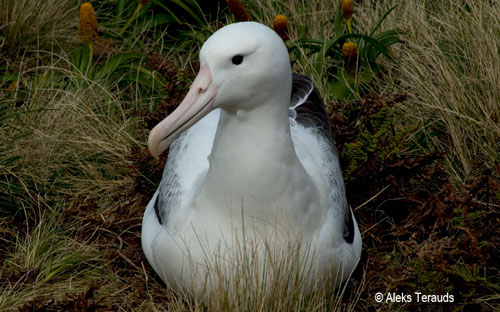 A Southern Royal Albatross sits in the grass; photo by Aleks Terauds
A Southern Royal Albatross sits in the grass; photo by Aleks Terauds
New Zealand’s Department of Conservation have released report, POP2022-11 Campbell Island seabird research 2023, by Claudia Mischler and Chrissy Wickes on research undertaken on Campbell Island involving Southern Royal Albatrosses.
The report’s summary follows,
This project (POP2022-11) was initially scoped as a desk-based project to identify cost-efficient monitoring methodologies for Campbell Island. However, when Operation Endurance (a collaboration between DOC and the Navy facilitating access to Campbell Island) was announced to take place in February 2023, POP2022-11 was re-scoped to implement actual monitoring, rather than identifying future monitoring avenues.
The February 2023 Operation Endurance trip to Campbell Island built on work from the March 2020 Operation Endurance trip, focusing on southern royal albatross (Diomedea epomophora). The main aims were counting of nests of southern royal albatross in the Col study area (and Moubray study area, if time permitted) to gain insight into population trends, deploying 29 GLS devices to gather long-term information on offshore distribution, collecting resight data (bands and PIT tags) for future demographic studies, and installing remote cameras at nests to study breeding biology, phenology, and success. Additional aims included counting of Antipodean albatross (Diomedea antipodensis) nests and conducting genomic sampling as well as deploying remote cameras on grey-headed albatross (Thalassarche chrysostoma) nests, if time permitted.
The trip to Campbell Island lasted one day, and hence it was only possible to deploy the 29 GLS tags and set up all 12 available remote cameras on southern royal albatross nests. No systematic search and count of the Col study area was possible, and there was insufficient time for Antipodean and grey-headed albatross work. Four banded southern royal albatrosses were resighted in the Col study area. Anecdotal evidence based on the limited nests sighted during this trip aligns with sightings during the 2020 trip and continues to suggest a concerning decline of the southern royal albatross at its stronghold. This is particularly alarming because even though southern royal albatross breed biennially, both cohorts (and hence the overall population) appear to be declining at the same rate because the 2020 survey covered one cohort and the 2023 survey the other.
An in-depth and up-to-date population study of southern royal albatross, including a thorough (preferably island-wide) nest count, is still needed to further assess the status of the southern royal albatross population and its trends.
Reference:
Mischler, C. & Wickes, C. 2023. Campbell Island/Motu Ihupuku Seabird Research & Operation Endurance February 2023. POP2022-11 final report prepared for Conservation Services Programme, Department of Conservation (New Zealand). 15 pp.
15 May 2023

 English
English  Français
Français  Español
Español